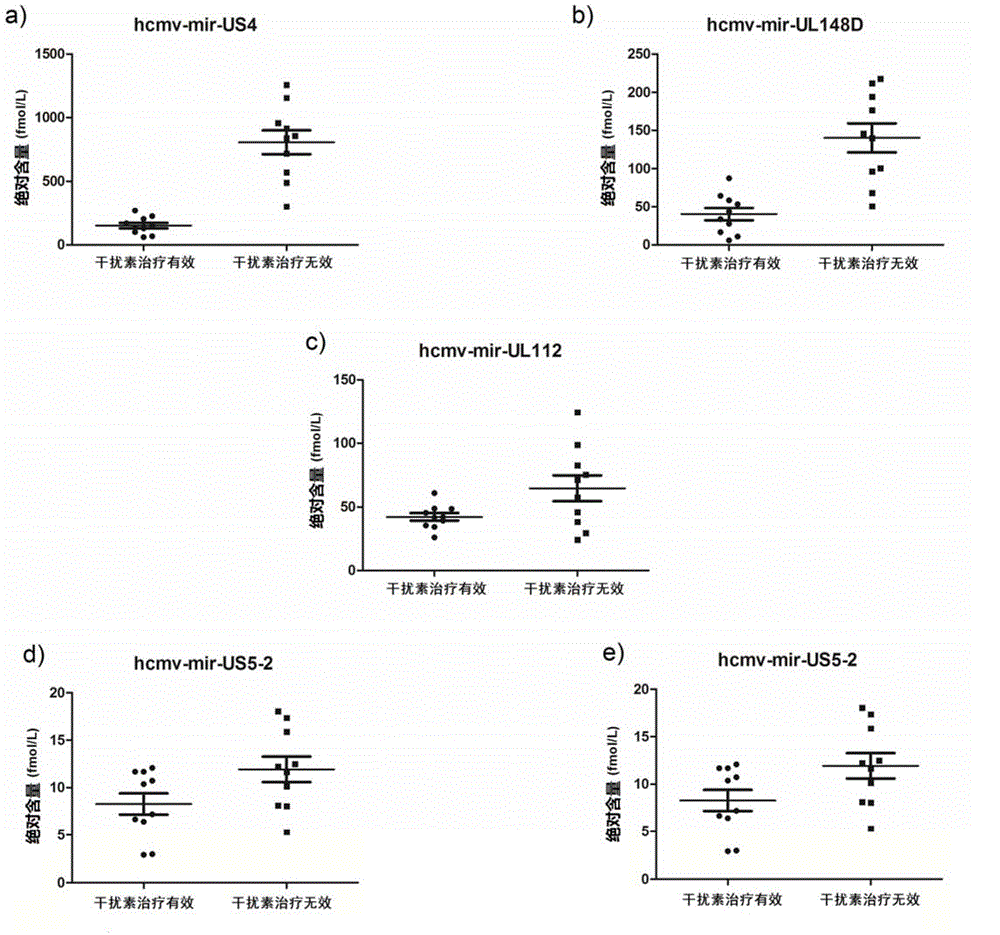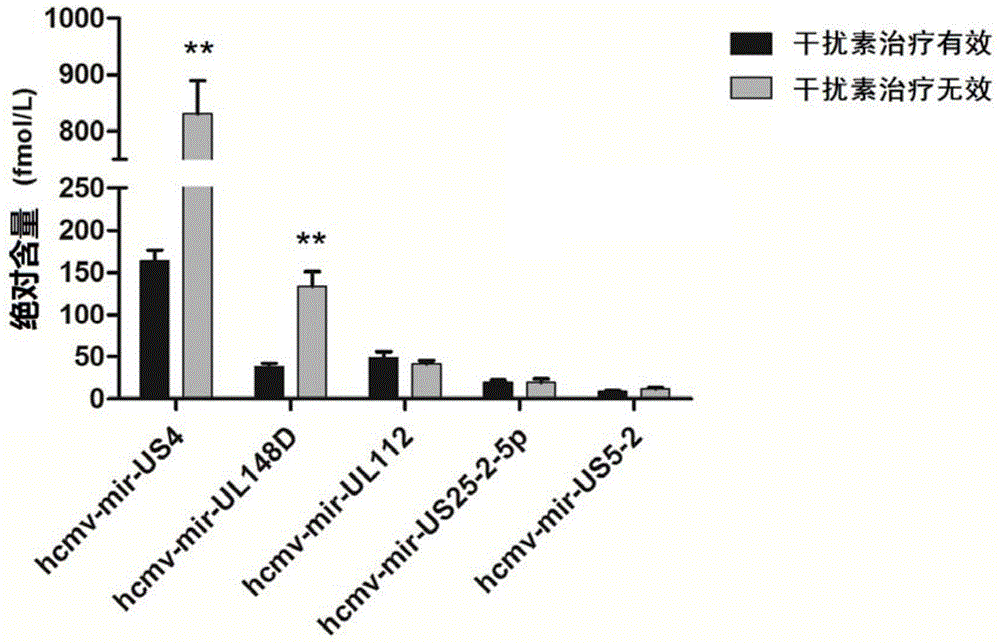MicroRNA used for predicting curative effect of interferon on chronic HBV and application thereof
An interferon, chronic technology, applied in the direction of microbial determination/inspection, DNA/RNA fragmentation, recombinant DNA technology, etc., to achieve the effect of saving cost and time, easy detection, and simplifying the primer library
- Summary
- Abstract
- Description
- Claims
- Application Information
AI Technical Summary
Problems solved by technology
Method used
Image
Examples
Embodiment 1
[0060] Example 1 Preliminary screening of specific HCMV miRNA expression profiles in patients with chronic hepatitis B
[0061] Quantitative PCR method was used to discover and prove that there were 5 differentially expressed microRNAs of human cytomegalovirus stably in the serum / plasma of 10 hepatitis B patients who were effective in interferon therapy and 10 hepatitis B patients who were ineffective in interferon therapy. The specific steps are:
[0062] (1) Collect serum / plasma from hepatitis B patients who are effective and ineffective in interferon therapy
[0063] (2) Prepare cDNA samples: a) Collect the serum / plasma of hepatitis B patients who are effective and ineffective in interferon treatment; b) Take 100ml of serum from each patient, add 1ml of QIAzol lysis Reagent, and mix well; c) Phase separation: Leave at room temperature for 5 minutes, then add 200ul chloroform to each portion, shake vigorously for 15s, room temperature for 2-3 minutes, centrifuge at 12,000g,...
Embodiment 2
[0069] Example 2 After the samples were reintegrated and the sample size was enlarged, the quantitative PCR method was used to detect the re-screened serum HCMV miRNA and its application and clinical value preliminary evaluation in the process of predicting the curative effect of interferon treatment of hepatitis B.
[0070] The qRT-PCR test of microRNA was performed on the serum of 18 hepatitis B patients who were effective in interferon therapy and 18 hepatitis B patients who were ineffective in interferon therapy. The experimental method and qRT-PCR result processing method are the same as those in Example 1.
[0071] The results of qRT-PCR further selected two HCMV microRNAs that were significantly differentially expressed in the serum of hepatitis B patients with effective interferon treatment and those with ineffective interferon treatment, namely hcmv-mir-US4 and hcmv-mir-UL148D. ( Figure 3-4 ).
[0072]In order to preliminarily evaluate the effect of these two micro...
Embodiment 3
[0075] Example 3 The double-blind experiment verifies the effect of the screened hcmv-miR-US4 as a biomarker in predicting the curative effect of interferon in the treatment of hepatitis B.
[0076] qRT-PCR test of hcmv-miR-US4 content in the serum of 102 cases of hepatitis B patients with unknown interferon treatment effect. The experimental method and qRT-PCR result processing method are the same as those in Example 1.
[0077] According to the results of Example 2, we used quantitative PCR to calculate the value of hcmv-miR-US4 content in the serum of patients with effective and ineffective interferon therapy: 289.58 ( Figure 8 ). And use this value to analyze and classify the qRT-PCR results, the prediction result is that 53 patients are ineffective with interferon treatment, and 49 patients are effective with interferon treatment. Comparing the predicted results with the actual clinical results, the correct rate reaches 77.45%. Using the TaqMan probe of hcmv-mir-US4 s...
PUM
 Login to View More
Login to View More Abstract
Description
Claims
Application Information
 Login to View More
Login to View More - R&D
- Intellectual Property
- Life Sciences
- Materials
- Tech Scout
- Unparalleled Data Quality
- Higher Quality Content
- 60% Fewer Hallucinations
Browse by: Latest US Patents, China's latest patents, Technical Efficacy Thesaurus, Application Domain, Technology Topic, Popular Technical Reports.
© 2025 PatSnap. All rights reserved.Legal|Privacy policy|Modern Slavery Act Transparency Statement|Sitemap|About US| Contact US: help@patsnap.com



